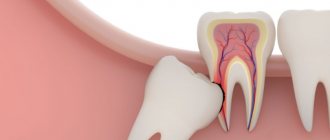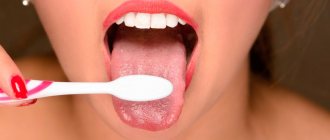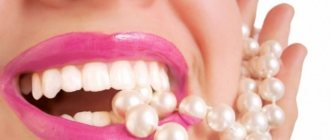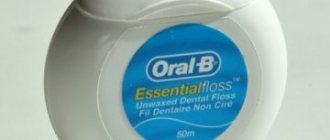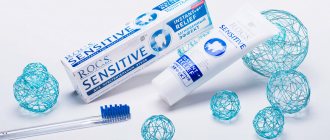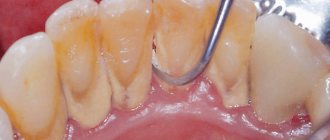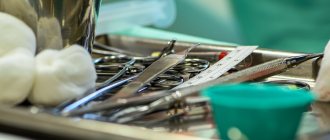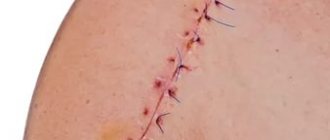Dentistry Apex-D / Memo for the patient / Recommendations after brushing your teeth
Recommendations after professional oral hygiene are a set of healing procedures for long-term preservation of the effect; subject to the recommended time interval between visits to the doctor, professional hygiene does not have any potential harmful effects on the tissues of the teeth and gums.
After cleaning dentures
In cases where the patient already has orthopedic structures installed, professional teeth cleaning is recommended at intervals of 3-4 months.
This depends on how carefully, correctly and regularly individual hygiene is carried out in the presence of artificial crowns, bridges and other types of prostheses, which determines the degree of healthy condition of one’s own teeth in contact with existing orthopedic structures.
Particular attention should be paid to the areas of contact between the prosthesis and the gingival margin. The appearance of a defect in the contact area makes it difficult to clean it and contributes to the intensive accumulation of plaque and food debris under the denture.
How often can you have your teeth cleaned by the dentist?
It is better to visit the clinic once every six months. This is enough to prevent dental diseases and eliminate accumulated deposits.
The procedure itself does not last long, about half an hour or a little more. The doctor first assesses the condition of the oral cavity, and then gives an opinion on the possibility or impossibility of professional treatment. If necessary, filling is performed, implants, prostheses and other orthopedic structures are installed. Thus, if there is a pathological process in the mouth, it is first of all important to get rid of it, and only then begin to remove plaque and whiten the units.
Recommendations after brushing your teeth
To maintain the effect for a longer time after carrying out complex measures for professional teeth cleaning, of course, you should strictly follow medical recommendations:
- To prevent the development of hyperesthesia and (increased tooth sensitivity) during the first few days, it is better to use toothpaste for sensitive teeth and be sure to start using a new toothbrush.
- To make the enamel non-traumatic at first, it is better to choose a toothbrush with ultra-soft bristles, which after three months can be replaced with super-soft or soft ones.
- In addition to regular hygiene products, interdental brushes and irrigators will not be superfluous, with the help of which the most inaccessible and interdental areas will remain clean.
- In the first two hours after comprehensive professional cavity hygiene, it is not recommended to eat or drink cold, hot, sour, sweet drinks and foods that can cause short-term pain symptoms characteristic of increased tooth sensitivity.
- Sudden temperature changes (for example, if you combine hot food with cold drinks or smoke outside in winter) subsequently cause microcracks in tooth enamel.
- Special antimicrobial and antiseptic gels and rinses prescribed by the doctor will help stop possible gum bleeding and temporary discomfort.
- Over the next 12 hours, you should exclude any coloring foods from your diet (tea, coffee, red wine, berries, mustard, ketchup, soy sauce, candy, etc.) and stop smoking.
- No earlier than a day later, it is advisable to start taking hard, raw, non-acidic fruits and vegetables (apples, carrots), which mechanically cleanse tooth enamel, and also perfectly massage the gums and stimulate normal blood circulation.
- Professional oral hygiene is especially recommended after therapeutic and orthopedic treatment.
For the convenience of our patients, the clinic offers a range of preventive and specialized personal hygiene products for the oral cavity, intended for use after surgical and orthopedic procedures: toothpastes and rinses containing chlorhexidine, gels for gums, toothbrushes of different hardness, interdental brushes and holders for them, irrigators, preparations for plaque indication.
In our dentistry in Moscow, we use safe and gentle methods and professional oral hygiene products at reasonable prices and offer attractive promotions for comprehensive oral care.
You can make an appointment at Apex-D Dentistry by calling the administrator at +7 and +7, or filling out an electronic form (the administrator will contact you at the specified phone number and agree on the date and time of the appointment).
Preventive measures
To avoid inflammatory processes in the oral cavity and relieve mild pain in the teeth, which sometimes occurs after removing tartar, you can rinse your mouth with medicinal decoctions, for example, St. John's wort, sage or even chamomile tea, which can be purchased at any pharmacy. If your teeth or gums continue to bother and hurt for a long time after hygienic cleaning, you should consult your doctor to make sure everything is okay.
Professional teeth cleaning, as well as home care, is an important and necessary procedure. By following all the doctor’s recommendations, not forgetting about the rules of hygiene, as well as regular preventive visits to the dentist and timely treatment, this is the only way you can protect your teeth from various diseases and defects. The health and beauty of your teeth depends on you, so take care of them from an early age!
Professional oral hygiene at Mositaldent
At the Mositaldent dental design clinic, you can count on truly high-quality professional oral hygiene services. We use only the most modern and high-quality drugs and the most modern and high-quality equipment. We competently carry out all preventive measures: everything so that dental services no longer cause horror, but can restore your self-confidence and give your smile beauty and health.
Category Hygiene Published by Mister stomatolog
Review and detailed analysis of all stages of comprehensive teeth cleaning
Professional teeth cleaning is a process of several stages, using certain technologies. Initially, the hygienist removes deposits that have hardened and formed a special stone on the teeth. Such deposits can be eliminated through the use of ultrasonic equipment.
Ultrasonic teeth cleaning
Tartar is hardened (or mineralized, in more professional terms) deposits on certain areas of the tooth.
Based on the area of formation, tartar is divided into supragingival and subgingival. The second type poses the greatest danger to humans, since it very often leads to gum inflammation in the future. Simple methods cannot get rid of such deposits, and only the use of ultrasonic equipment can eliminate them.
When performing cleaning, ultrasonic waves destroy deposits even in the most difficult to reach areas, and at the same time harmful microflora, which can lead to inflammation. Timely use of teeth cleaning will help avoid various dental problems. Such as, for example, periodontitis or periodontal disease.
Dentists use a special device (scaler) to solve these problems. It creates the necessary ultrasonic waves. It has a tip with a special attachment that transmits waves to the areas that need to be treated. It is also supplied with water or antiseptic. The dentist, using the device, can change the intensity of vibrations, selecting the most suitable mode for the patient.
How is tartar removed?
When performing such cleaning, it is destroyed due to the following:
- Ultrasound has a mechanical effect on hardened areas. The waves gently crush the stone into small pieces, which are easily removed with water or a special vacuum cleaner for the oral cavity;
- The simultaneous supply of liquid and ultrasound leads to the formation of a cavitation effect, during which a huge number of microbubbles are created. They blur plaque and speed up its separation from the tooth surface.
Important! Before it became possible to use ultrasound, tartar was removed exclusively with hand tools. Because of this, the procedure was very long and complicated. The dentist could easily injure the soft tissues, since the instrument used was extremely sharp, so the whole procedure could hardly be called pleasant. The most negative point in all this was that during the procedure, tooth enamel was significantly damaged. This was due to the fact that to remove plaque it was necessary to remove a layer of healthy tissue. After performing this type of cleaning, patients often experienced unpleasant dental hypersensitivity. The use of ultrasound allows you to avoid all these problems. Ultrasonic cleaning is absolutely safe; it does not injure the gums or mucous membranes.
It is very important that all procedures are carried out using modern equipment, without any disruptions in the process, only then the cleaning will be carried out professionally and will be safe. To do this, it is important that the hygienist has experience working with a scaler: the tip of the device should move only along areas of the tooth at a specific angle, and the cleaning itself should be accompanied by a significant supply of water to the teeth. It is very important to follow this process technology, since violations can damage the enamel or overheat the pulp, which can lead to various complications.
Our dental clinic carries out such cleaning only under the guidance of professional hygienists, as well as using modern equipment, so patients have nothing to fear and are guaranteed an impeccable result.
Important! A positive feature of using ultrasound, as opposed to other types of cleaning (with the exception of laser cleaning), is that it kills pathogenic microflora. For this reason, this procedure is highly recommended for patients with gum disease, because ultrasound kills pathogenic microflora in all areas, including periodontal pockets.
You should not be afraid of such cleaning, because it does not cause pain at all. If you are concerned that they may occur, you can ask the hygienist to pre-administer anesthesia. With this option there will definitely be no pain. Otherwise, ultrasonic cleaning is very fast. Up to 60 minutes, the exact time depends on how much deposits are observed in the oral area.
Important! If you have hypersensitivity or have a lot of deposits in the subgingival pockets, then there may be some pain during ultrasonic cleaning, and this is normal. In order to remove them, you need to administer anesthesia before cleaning. It can be administered not by injection, but by applying a local application. Therefore, there is no need to be afraid or panic.
Once this stage has been successfully completed, the hygienist moves on to the next stage and performs cleaning using Air Flow technology.
2.Air Flow
During the Air Flow teeth cleaning procedure, a special sandblasting device is used, which, using air and water, delivers a composition with abrasive particles to the enamel surface. The liquid is supplied in a powerful stream, which allows you to cleanse your teeth of bacteria and plaque in a short period of time. This method is effective not only for removing loose deposits, but also pigmented plaque that is firmly embedded in the enamel.
Air Flow is an innovative technology for cleaning teeth, which has a number of undeniable advantages:
- Air Flow easily fights plaque located in hard-to-reach areas of the oral cavity, which helps get rid of bad breath.
- The procedure can be performed without the use of anesthesia. It does not cause pain or discomfort. Mild pain may occur in patients with hypersensitivity.
- During the Air Flow procedure, aromatic liquids are used that can give freshness to your breath and turn cleaning into a pleasant, painless process.
- In liquids for the Air Flow procedure, soda is used, crushed to a powder state. This means that the risk of injury to tooth enamel during the cleaning process is completely eliminated.
- Air Flow effectively removes pigmented plaque. The procedure is indispensable for smokers and lovers of strong coffee and black tea. Excessive consumption of coffee and tobacco negatively affects the whiteness of the enamel, making it yellow. Air Flow quickly removes unpleasant plaque, restoring your teeth to their attractive appearance.
- During cleaning, do not use liquids with caustic chemical composition. This means that cleaning is safe and does not cause allergic reactions or other unpleasant consequences.
- The air-abrasive flow helps restore teeth to their natural white color and make your smile more attractive.
IMPORTANT: Using Air Flow technology, the doctor independently adjusts the power of the water-air flow onto the enamel surface, taking into account the individual characteristics of the patient’s teeth. The dentist takes into account the structure and condition of the enamel and whether there is hypersensitivity. This approach helps to achieve high efficiency and complete safety for patients.
Why does professional cleaning combine two techniques - Air Flow and ultrasound?
This question worries many patients. Hygienists explain that only a combination of two cleanings can achieve the desired result and carry out the procedure for cleansing the oral cavity from bacterial plaque at the proper level.
Air Flow cleaning works great at removing pigmented plaque that has become embedded in the pores of the enamel, but it will not be able to remove hard tartar, and is ineffective in the presence of mineralized deposits located in periodontal pockets.
Ultrasonic cleaning works well to remove tartar, but the metal tip of the scaler cannot penetrate the space between teeth (it is especially difficult to clean the interdental space in patients whose teeth are too close together). That is why these methods are used in combination. During professional cleaning, ultrasound and Air Flow methods are used.
IMPORTANT: Air Flow and ultrasonic cleaning can lighten tooth enamel to a natural level - by 2 tones. For those who want to achieve a more pronounced effect, after cleaning they should resort to a professional whitening procedure.
Teeth polishing is one of the mandatory stages of professional cleaning.
The third stage of brushing your teeth involves mandatory polishing of your teeth. Using polishing, the dentist eliminates all irregularities and microcracks in the enamel that form after cleaning the teeth of accumulated deposits. Professional teeth cleaning is impossible without polishing, since roughness will remain on the enamel, which promotes the adhesion of microparticles of food.
As a result, a layer of plaque forms again, which subsequently mineralizes and turns into tartar. Teeth polishing carried out after professional cleaning significantly slows down the process of plaque formation and keeps teeth shiny and smooth for a long time.
Teeth polishing after brushing is carried out using a special tool with several replaceable attachments. Each of them performs a specific task:
- Needle-shaped attachments are used to grind the surfaces of teeth and the gingival zone;
- Brushes help remove remaining plaque particles from rough areas of teeth;
- Crowns and dentures made of different materials are processed with different types of polishers;
- Discs allow you to give ideal smoothness and shine to cleaned teeth.
Treatment of interdental spaces after professional cleaning is carried out using special strips, as they easily fit into the narrow space between the teeth.
The process of polishing teeth after professional cleaning involves the use of not only tools, but also several types of pastes with varying degrees of abrasiveness. In addition to abrasive particles, polishing pastes contain fluorine and xylitol, which are involved in strengthening teeth.
Stages of teeth polishing after professional cleaning
- Polishing the outer surface of teeth using tools and paste;
- The treatment of flat surfaces is followed by polishing the fissures (tubercles) of the chewing teeth;
- Polishing the spaces between teeth with strips.
The average duration of teeth polishing performed after professional cleaning is 30-40 minutes. This does not require anesthesia, since the process of polishing teeth is a painless procedure that does not cause discomfort to the patient. Upon completion of polishing, the oral cavity must be rinsed with water, after which the dentist carries out the final stage of professional teeth cleaning - fluoridation.
4. Fluoridation is the final stage of professional teeth cleaning
Fluoridation is not a mandatory procedure after professional teeth cleaning, but you should not refuse it, as it combats increased sensitivity of teeth, strengthens enamel and prevents the occurrence of caries. Fluoridation involves treating tooth surfaces with fluorides.
Benefits of fluoridation:
- Normalizing the level of fluoride in the body, strengthening teeth and increasing the strength of enamel;
- Stops the process of leaching calcium, which is so important for dental health;
- Slowing down the proliferation of pathogenic bacteria in the oral cavity and the formation of plaque.
The process of fluoridation of teeth occurs as follows: the teeth are dried with an air stream directed at them. Next, using trays or a brush, a solution enriched with useful substances is applied to each tooth. Fluoridation is the final stage of professional teeth cleaning. But after the procedure, every dentist will definitely give recommendations on proper care of your teeth and oral cavity.
Additional care products
Dental floss, floss. Used to clean interdental spaces. After professional cleaning, use floss carefully so as not to injure the edges of the gums. Movements are directed from the gums to the cutting edge or to the chewing surface of the crown. Floss is used several times a day, as needed (after meals, after morning and evening brushing of teeth).
Irrigator. Using an irrigator helps to maintain the results of professional hygiene for a long time. The device cleans enamel with a thin stream of water under pressure. This type of cleaning removes soft plaque well and prevents the formation of tartar. The irrigator is used once a week or less. It is better if the frequency of such cleanings is determined by a doctor, taking into account the condition of the enamel.

